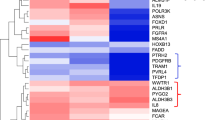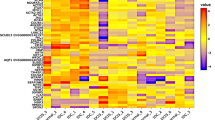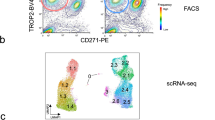Abstract
Breast cancer is the most common malignancy for women, with invasive ductal carcinoma being the largest subtype of breast cancers, accounting for 75–80% of cases. However, the underlying mechanism of invasive ductal carcinoma remains unclear. In this study, we investigate the possible effects KDM3B-ETF1 fusion gene has on breast cancer cell metastasis, invasion and its downstream signaling mediators as revealed from RNA sequence data analysis. As predicted, KDM3B-ETF1 expression was increased in breast cancer tissues and cells. Overexpression of KDM3B-ETF1 in cancer cell lines promoted the growth and invasion of breast cancer cells, while KDM3B-ETF1 knockdown showed the opposite effects on malignant cell growth and invasion both in vivo and in vitro as evidenced by cell counting kit-8, Transwell assay and tumor xenograft in nude mice. On the contrary, LIM Domain Only 2 (LMO2) expression was significantly reduced in breast cancer tissues and cells. According to chromatin immunoprecipitation and Western blot analysis, KDM3B-ETF1 targets LMO2 and reduced the expression of LMO2, leading to an increase in WNT/β-catenin signaling pathway and thus promoting invasion. In conclusion, fusion gene KDM3B-ETF1 inhibits LMO2, activates the Wnt/β-catenin signaling pathway that leads to increased breast cancer cell invasion and metastasis, providing a novel insight into developing therapeutic strategies. These results provide novel insights into the molecular mechanism of invasive ductal carcinomas, which may lead to potential therapeutic targets.
This is a preview of subscription content, access via your institution
Access options
Subscribe to this journal
Receive 12 print issues and online access
269,00 € per year
only 22,42 € per issue
Buy this article
- Purchase on SpringerLink
- Instant access to full article PDF
Prices may be subject to local taxes which are calculated during checkout






Similar content being viewed by others
References
Ernster VL, Ballard-Barbash R, Barlow WE, Zheng Y, Weaver DL, Cutter G, et al. Detection of ductal carcinoma in situ in women undergoing screening mammography. J Natl Cancer Inst. 2002;94:1546–54.
Randolph WM, Goodwin JS, Mahnken JD, Freeman JL. Regular mammography use is associated with elimination of age-related disparities in size and stage of breast cancer at diagnosis. Ann Intern Med. 2002;137:783–90.
Kerlikowske K, Creasman J, Leung JW, Smith-Bindman R, Ernster VL. Differences in screening mammography outcomes among White, Chinese, and Filipino women. Arch Intern Med. 2005;165:1862–8.
Kerlikowske K, Miglioretti DL, Buist DS, Walker R, Carney PA. National Cancer Institute-Sponsored Breast Cancer Surveillance C. Declines in invasive breast cancer and use of postmenopausal hormone therapy in a screening mammography population. J Natl Cancer Inst. 2007;99:1335–9.
Claus EB, Stowe M, Carter D. Breast carcinoma in situ: risk factors and screening patterns. J Natl Cancer Inst. 2001;93:1811–7.
Wohlfahrt J, Rank F, Kroman N, Melbye M. A comparison of reproductive risk factors for CIS lesions and invasive breast cancer. Int J Cancer. 2004;108:750–3.
Kerlikowske K, Miglioretti DL, Ballard-Barbash R, Weaver DL, Buist DS, Barlow WE, et al. Prognostic characteristics of breast cancer among postmenopausal hormone users in a screened population. J Clin Oncol. 2003;21:4314–21.
Kerlikowske K. Epidemiology of ductal carcinoma in situ. J Natl Cancer Inst Monogr. 2010;2010:139–41.
Han A, Chae YC, Park JW, Kim KB, Kim JY, Seo SB. Transcriptional repression of ANGPT1 by histone H3K9 demethylase KDM3B. BMB Rep. 2015;48:401–6.
An MJ, Kim DH, Kim CH, Kim M, Rhee S, Seo SB, et al. Histone demethylase KDM3B regulates the transcriptional network of cell-cycle genes in hepatocarcinoma HepG2 cells. Biochem Biophys Res Commun. 2019;508:576–82.
Li J, Yu B, Deng P, Cheng Y, Yu Y, Kevork K, et al. KDM3 epigenetically controls tumorigenic potentials of human colorectal cancer stem cells through Wnt/beta-catenin signalling. Nat Commun. 2017;8:15146.
Kim JY, Kim KB, Eom GH, Choe N, Kee HJ, Son HJ, et al. KDM3B is the H3K9 demethylase involved in transcriptional activation of lmo2 in leukemia. Mol Cell Biol. 2012;32:2917–33.
Sarac H, Morova T, Pires E, McCullagh J, Kaplan A, Cingoz A, et al. Systematic characterization of chromatin modifying enzymes identifies KDM3B as a critical regulator in castration resistant prostate cancer. Oncogene. 2020;39:2187–201.
Paolicchi E, Crea F, Farrar WL, Green JE, Danesi R. Histone lysine demethylases in breast cancer. Crit Rev Oncol Hematol. 2013;86:97–103.
Frolova L, Le Goff X, Rasmussen HH, Cheperegin S, Drugeon G, Kress M, et al. A highly conserved eukaryotic protein family possessing properties of polypeptide chain release factor. Nature. 1994;372:701–3.
Dubourg C, Toutain B, Helias C, Henry C, Lessard M, Le Gall JY, et al. Evaluation of ETF1/eRF1, mapping to 5q31, as a candidate myeloid tumor suppressor gene. Cancer Genet Cytogenet. 2002;134:33–7.
Armakolas A, Stathopoulos GP, Nezos A, Theos A, Stathaki M, Koutsilieris M. Subdivision of molecularly-classified groups by new gene signatures in breast cancer patients. Oncol Rep. 2012;28:2255–63.
Edwards PA. Fusion genes and chromosome translocations in the common epithelial cancers. J Pathol. 2010;220:244–54.
Liu Y, Huang D, Wang Z, Wu C, Zhang Z, Wang D, et al. LMO2 attenuates tumor growth by targeting the Wnt signaling pathway in breast and colorectal cancer. Sci Rep. 2016;6:36050.
Liu Y, Wang Z, Huang D, Wu C, Li H, Zhang X, et al. LMO2 promotes tumor cell invasion and metastasis in basal-type breast cancer by altering actin cytoskeleton remodeling. Oncotarget. 2017;8:9513–24.
Krishnamurthy N, Kurzrock R. Targeting the Wnt/beta-catenin pathway in cancer: Update on effectors and inhibitors. Cancer Treat Rev. 2018;62:50–60.
King TD, Suto MJ, Li Y. The Wnt/beta-catenin signaling pathway: a potential therapeutic target in the treatment of triple negative breast cancer. J Cell Biochem. 2012;113:13–8.
Mukherjee N, Panda CK. Wnt/beta-catenin signaling pathway as chemotherapeutic target in breast cancer: an update on pros and cons. Clin Breast Cancer. 2020;20:361–70.
Wang SM. Concerns on diagnosis and treatment of breast cancer in China. Chin Med J (Engl). 2007;120:1741–2.
Danneman PJ, Michael JG. Regulation of reaginic antibody production in mice. I. Suppression by antigen of IgE antibody production in vitro. J Exp Med. 1977;146:1534–48.
Rao C, Liu B, Huang D, Chen R, Huang K, Li F, et al. Nucleophosmin contributes to vascular inflammation and endothelial dysfunction in atherosclerosis progression. J Thorac Cardiovasc Surg. 2019. https://doi.org/10.1016/j.jtcvs.2019.10.152.
Zhou S, Luo Q, Tan X, Huang W, Feng X, Zhang T, et al. Erchen decoction plus huiyanzhuyu decoction inhibits the cell cycle, migration and invasion and induces the apoptosis of laryngeal squamous cell carcinoma cells. J Ethnopharmacol. 2020;256:112638.
Ma HL, Yu SJ, Chen J, Ding XF, Chen G, Liang Y, et al. CA8 promotes RCC proliferation and migration though its expression level is lower in tumor compared to adjacent normal tissue. Biomed Pharmacother. 2020;121:109578.
Zhang Y, Chen J, Wu SS, Lv MJ, Yu YS, Tang ZH, et al. HOXA10 knockdown inhibits proliferation, induces cell cycle arrest and apoptosis in hepatocellular carcinoma cells through HDAC1. Cancer Manag Res. 2019;11:7065–76.
Han F, Xu Q, Zhao J, Xiong P, Liu J. ERO1L promotes pancreatic cancer cell progression through activating the Wnt/catenin pathway. J Cell Biochem. 2018;119:8996–9005.
Yu Z, Wang Z, Li F, Yang J, Tang L. miR138 modulates prostate cancer cell invasion and migration via Wnt/betacatenin pathway. Mol Med Rep. 2018;17:3140–5.
Shan Y, Ying R, Jia Z, Kong W, Wu Y, Zheng S, et al. LINC00052 promotes gastric cancer cell proliferation and metastasis via activating the Wnt/beta-catenin signaling pathway. Oncol Res. 2017;25:1589–99.
Acknowledgements
This study was supported by Key Science and Technology Projects of Department of science and technology in Henan Province (No. 161100311400).
Author information
Authors and Affiliations
Contributions
AH and KC designed the study. FH and LZ were involved in data collection. DL and QX performed the statistical analysis and preparation of figures. HH drafted the paper. All authors read and approved the final manuscript.
Corresponding author
Ethics declarations
Conflict of interest
The authors declare no competing interests.
Ethical approval
This study was approved by the ethics committee of Henan Provincial People’s Hospital in strict accordance with principles outlined in the Helsinki Declaration and the informed consent of all subjects was provided. Animal use and experimental procedures were performed with the approval of the Experimental Animal Ethics Committee of Henan Provincial People’s Hospital. All efforts were made to reduce the suffering of animals.
Additional information
Publisher’s note Springer Nature remains neutral with regard to jurisdictional claims in published maps and institutional affiliations.
Supplementary information
Rights and permissions
About this article
Cite this article
Hu, A., Hong, F., Li, D. et al. KDM3B-ETF1 fusion gene downregulates LMO2 via the WNT/β-catenin signaling pathway, promoting metastasis of invasive ductal carcinoma. Cancer Gene Ther 29, 215–224 (2022). https://doi.org/10.1038/s41417-021-00301-z
Received:
Revised:
Accepted:
Published:
Issue Date:
DOI: https://doi.org/10.1038/s41417-021-00301-z
This article is cited by
-
Epigenetic roles of KDM3B and KDM3C in tumorigenesis and their therapeutic implications
Cell Death & Disease (2024)



